Why you can trust Tom's Hardware
Comparison Products
First things first: we want to see how the SM2508 measures up to the competition. We’ve chosen the fastest E26-based drive, the Sabrent Rocket 5, and an IG5666-based drive, the Adata Legend 970 Pro, for direct comparison. These drives were tested at 2TB but are using 1Tb dies, so this is somewhat of a fair fight. Just in case, though, we’ll also include the 1TB PNY CS3150, Gigabyte Aorus Gen5 12000, and Nextorage NE5N.
Sliding down to PCIe 4.0 drives, we’re looking at the Micron 3500 — an OEM Crucial T500, but reviewed at 1TB — to see how this new controller stacks up against a modern low-power solution. We also have some of the best 4.0 drives with the WD Black SN850X, Kingston KC3000, and Sabrent Rocket 4 Plus-G. Finally, representing the budget market we have the Teamgroup MP44L.
Trace Testing — 3DMark Storage Benchmark
Built for gamers, 3DMark’s Storage Benchmark focuses on real-world gaming performance. Each round in this benchmark stresses storage based on gaming activities including loading games, saving progress, installing game files, and recording gameplay video streams. Future gaming benchmarks will be DirectStorage-inclusive and we also include notes about which drives may be future-proofed.



Unsurprisingly, the SM2508 sample is the fastest drive we’ve ever tested in 3DMark. Okay, it only wins by a hair, so that’s a bit of hyperbole. In reality it’s neck-and-neck with existing technology, which is still incredibly fast.
Trace Testing — PCMark 10 Storage Benchmark
PCMark 10 is a trace-based benchmark that uses a wide-ranging set of real-world traces from popular applications and everyday tasks to measure the performance of storage devices. The results are particularly useful when analyzing drives for their use as primary/boot storage devices and in work environments.



Our sample is again near the top, alongside the Rocket 5 and CS3150. There’s a limit to how fast you can get with current technology on this interface. This is good news in the sense that you can pick from multiple drives based on what you like in terms of aesthetics after considering price. Any of these high-end PCIe 5.0 drives will be super fast. On the other hand, there are hidden differences like power efficiency that shouldn’t be ignored.
Console Testing — PlayStation 5 Transfers
The PlayStation 5 is capable of taking one additional PCIe 4.0 or faster SSD for extra game storage. While any 4.0 drive will technically work, Sony recommends drives that can deliver at least 5,500 MB/s of sequential read bandwidth for optimal performance. In our testing, PCIe 5.0 SSDs don't bring much to the table and generally shouldn't be used in the PS5, especially as they may require additional cooling. Check our Best PS5 SSDs article for more information.
Our testing utilizes the PS5’s internal storage test and manual read/write tests with over 192GB of data both from and to the internal storage. Throttling is prevented where possible to see how each drive operates under ideal conditions. While game load times should not deviate much from drive to drive, our results can indicate which drives may be more responsive in long-term use.
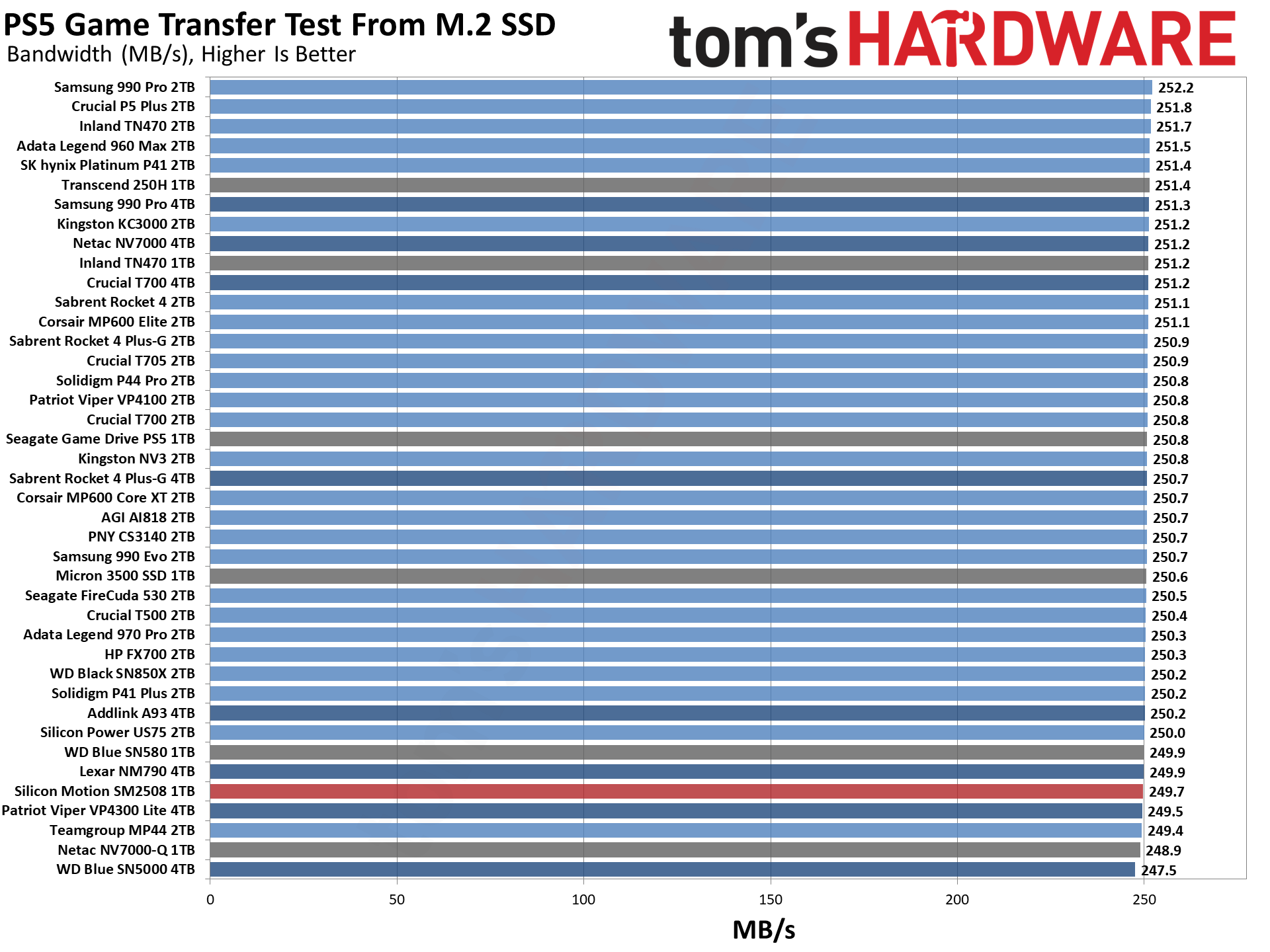


Here, finally, is a PCIe 5.0 drive that might actually make sense in the PS5 from a thermal standpoint, although it should probably use a heatsink anyway. (We use the Sabrent PS5 cover for all our PS5 SSD testing, though the debug pins on this engineering sample prevented it from fitting properly.) The 2TB and 4TB versions would presumably put out more peak heat, too. In any case, it’s not economically wise to use a drive like this in the PS5, but if you did it would perform perfectly well.
Get Tom's Hardware's best news and in-depth reviews, straight to your inbox.
Transfer Rates — DiskBench
We use the DiskBench storage benchmarking tool to test file transfer performance with a custom, 50GB dataset. We write 31,227 files of various types, such as pictures, PDFs, and videos to the test drive, then make a copy of that data to a new folder, and follow up with a reading test of a newly-written 6.5GB zip file. This is a real world type workload that fits into the cache of most drives.



Copy and transfer performance scales with the interface. A fast PCIe 5.0 SSD is about as good as it gets right now, although more performance can be had with a larger drive — 2TB or more — and with faster flash. If you’re going for a PCIe 5.0 drive, you'll probably want the top performing model, and anything based on the SM2508 should fit the bill. This is unlike the E26, which saw a gradual swing upward in performance as faster drives based on the controller came out.
Synthetic Testing — ATTO / CrystalDiskMark
ATTO and CrystalDiskMark (CDM) are free and easy-to-use storage benchmarking tools that SSD vendors commonly use to assign performance specifications to their products. Both of these tools give us insight into how each device handles different file sizes and at different queue depths for both sequential and random workloads.

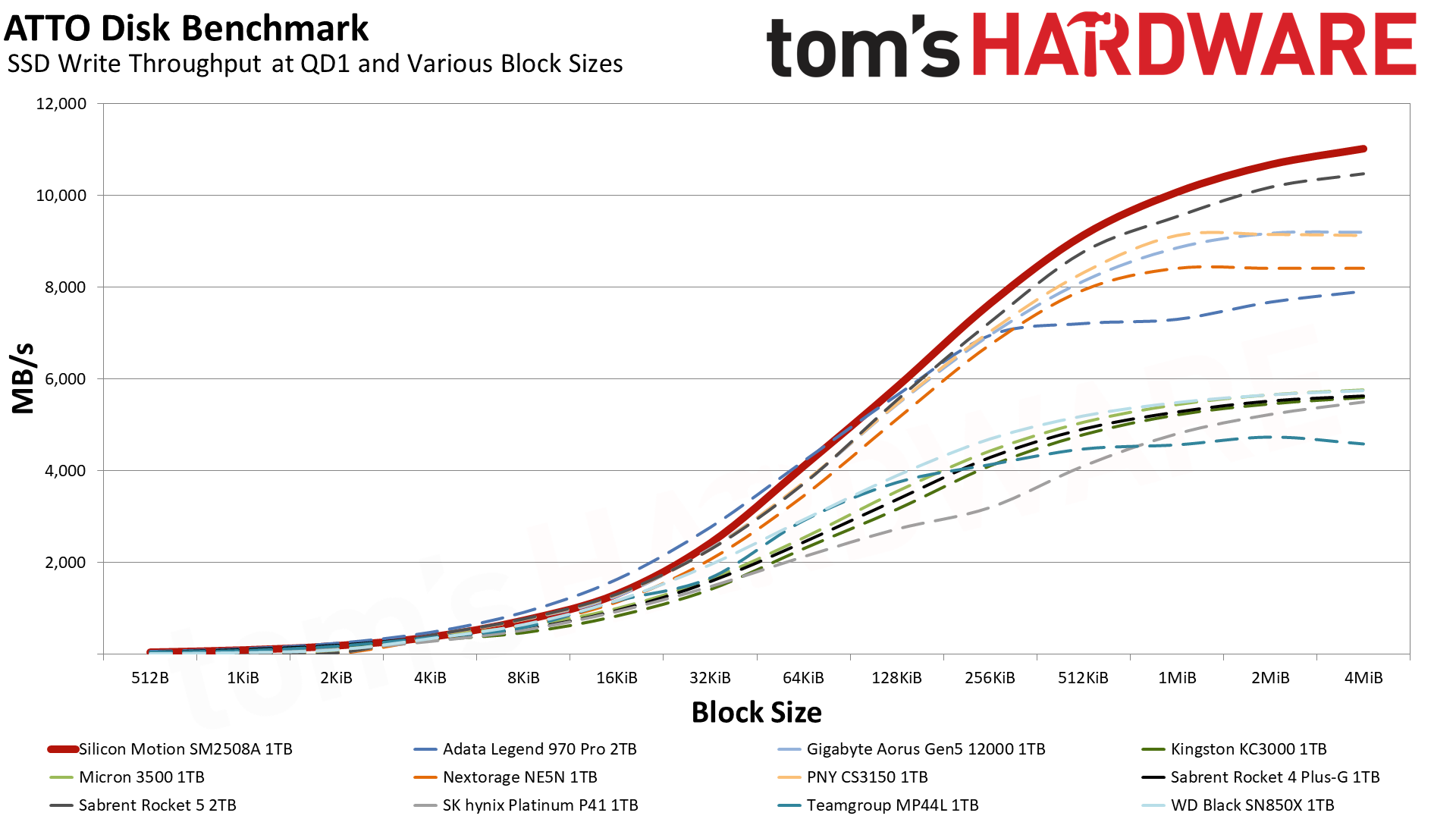
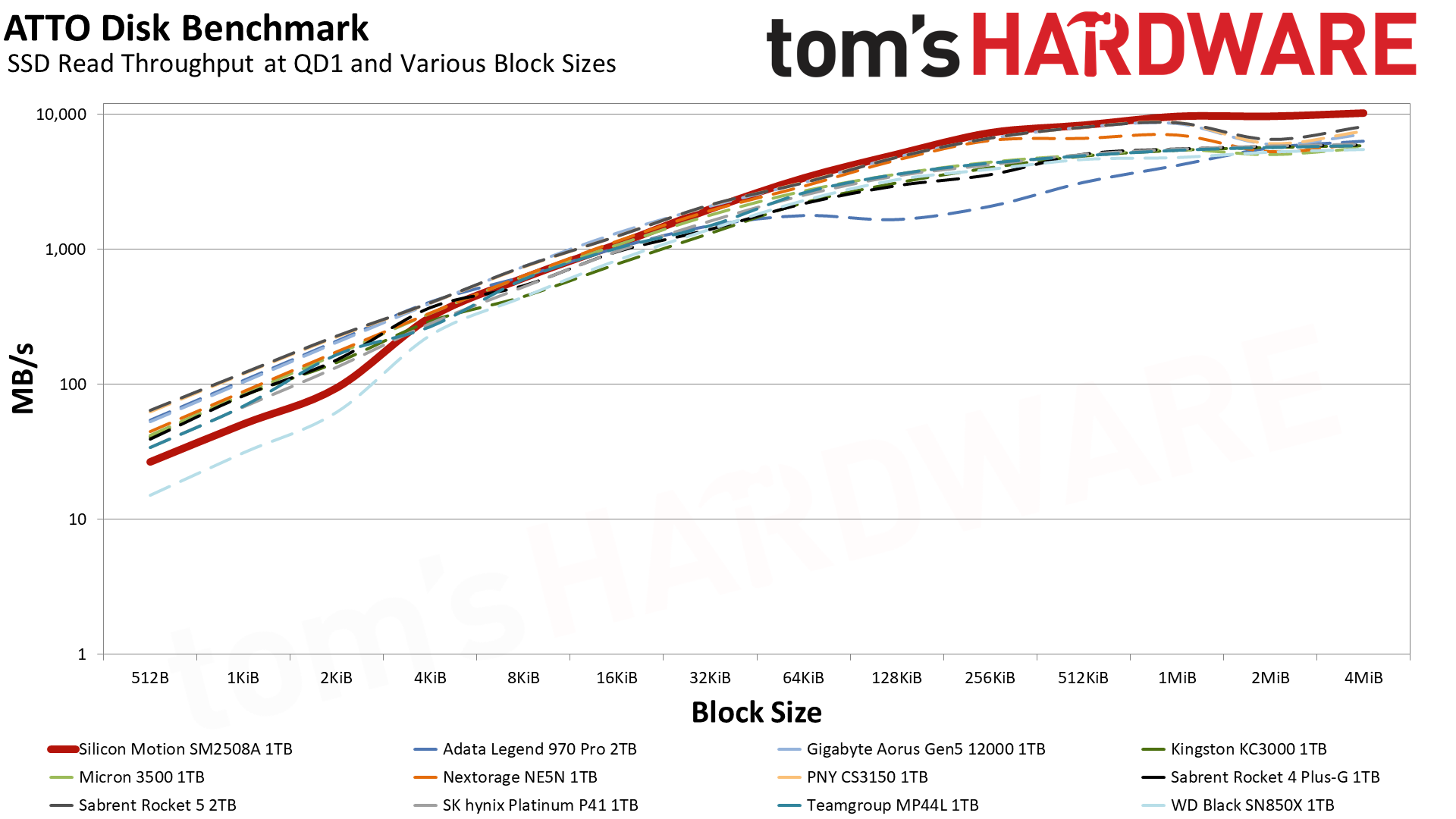




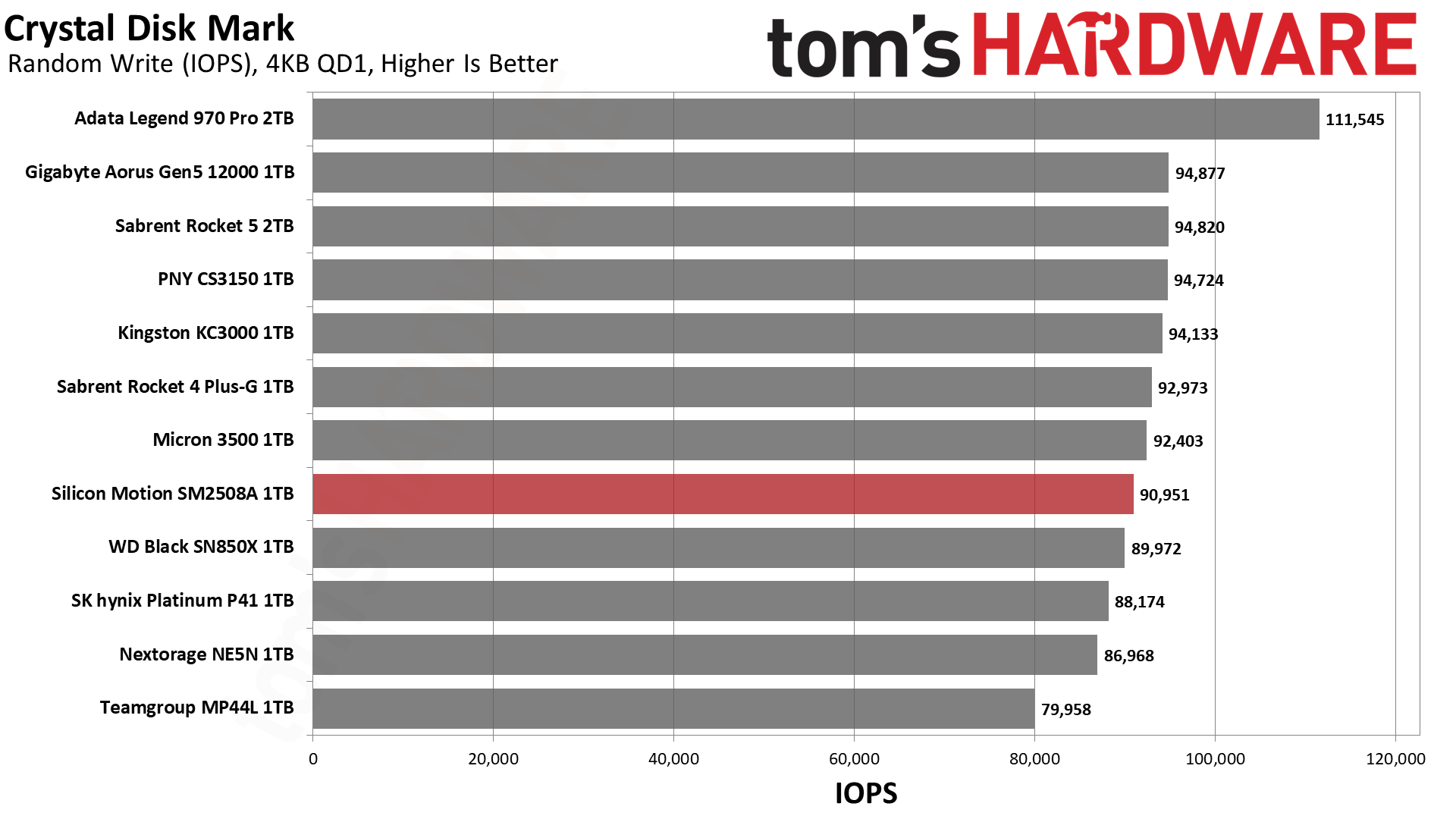






Our sample performed admirably in ATTO, yielding some of the best results we’ve ever seen. The drive also does not display the characteristic Phison valley at higher block sizes. In CDM, sequential performance is also quite good across the board. It matches or beats the Rocket 5.
Specifically, the SM2508 drive pulls away with sequential writes, which matches expectations from the specifications sheet — this controller is capable of faster write speeds than the E26 and IG5666. A significant reason for this is probably power consumption. The SM2508 is much more power-efficient and so can maximize write performance while staying within reasonable power limits. The E26 and IG5666 drives can potentially exceed M.2 power limits with sustained writes and thus have to throttle slightly.
The SM2508 can also push more IOPS, possibly for a similar reason and especially since the lower power draw lets the Cortex-R8 cores hum, but it brings nothing new to the table in terms of 4KB QD1 random performance. The results are still good, just not earth-shattering. There’s only so much you can do with BiCS6. BiCS8, as proposed, could have significantly lower read latency, but real world performance remains to be seen.
Sustained Write Performance and Cache Recovery
Official write specifications are only part of the performance picture. Most SSDs implement a write cache, which is a fast area of pseudo-SLC (single-bit) programmed flash that absorbs incoming data. Sustained write speeds can suffer tremendously once the workload spills outside of the cache and into the "native" TLC (three-bit) or QLC (four-bit) flash. Performance can suffer even more if the drive is forced to fold, which is the process of migrating data out of the cache in order to free up space for further incoming data.
We use Iometer to hammer the SSD with sequential writes for over 15 minutes (we did a 60 minute run on the SM2508) to measure both the size of the write cache and performance after the cache is saturated. We also monitor cache recovery via multiple idle rounds. This process shows the performance of the drive in various states as well as the steady state write performance.


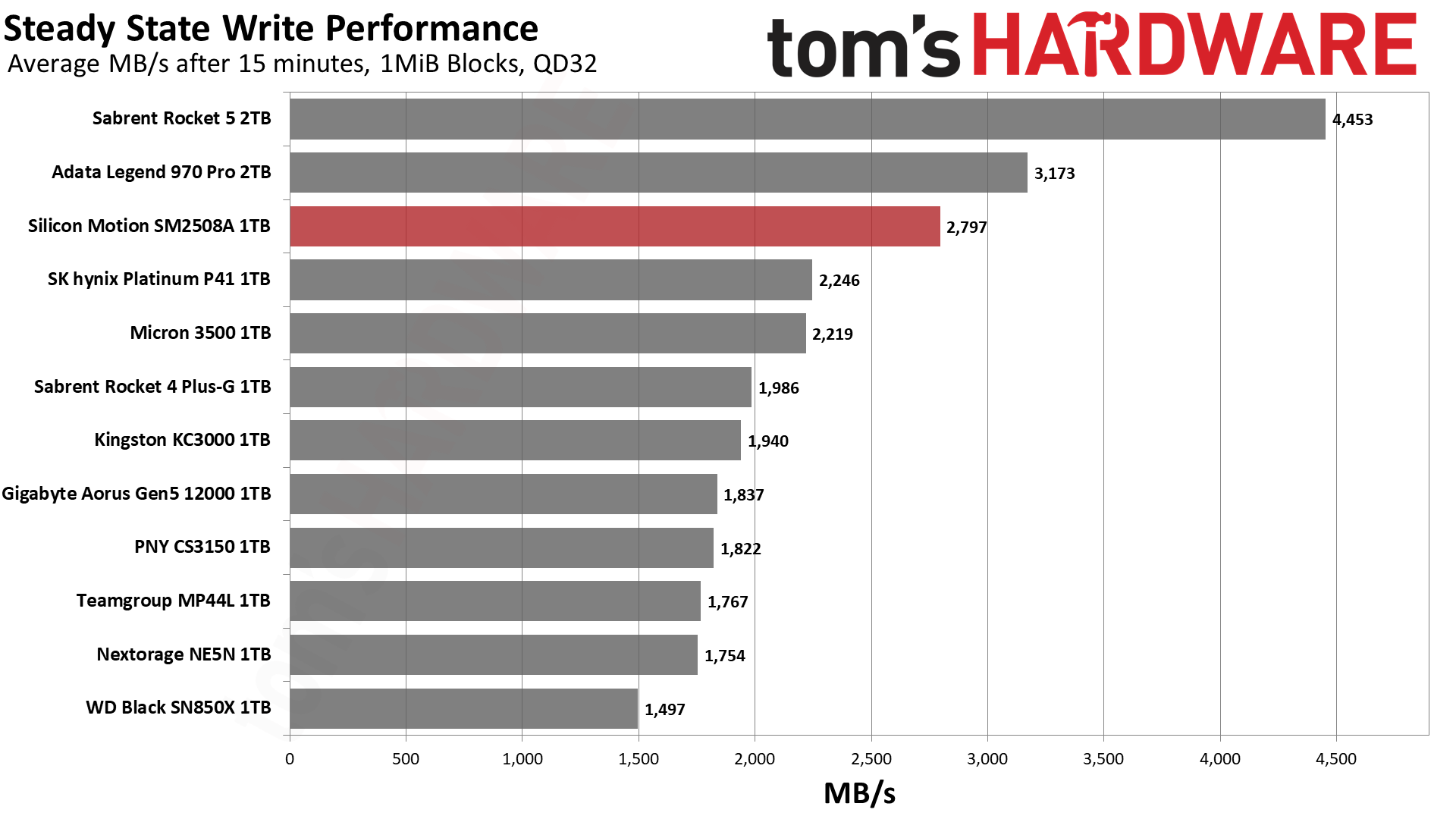
This is a pretty interesting test for this drive. At first, we weren’t sure this was really BiCS6 TLC flash, given the relatively decent performance. The answer is it's using 512Gb dies — this means twice the interleaving of the typical 1Tb dies we usually see, given the same capacity. These dies are more commonly used in enterprise, but I digress. If drives based on this controller go to 1Tb dies for 2TB SKUs, there might not be any real uplift here. However, 512Gb dies at that capacity could lead to a higher baseline speed and 1Tb dies for a 4TB drive may as well.
The 1TB sample we have today writes in pSLC mode for 12.5 seconds at 12.9 GB/s for a cache of around 160GB. Translating this back to 3-bit TLC, that’s about half the drive being used for caching. It's a reasonably large cache but certainly not the largest we’ve seen, and using a smaller cache can have benefits for sustained performance.
In this case, the drive hits direct to TLC mode after the cache is exhausted and is able to write at almost 2.8 GB/s. That's a very good result for a 1TB drive. Given the drive’s power efficiency — see below — it could definitely operate as a workhorse. It will be interesting to see how it runs at higher capacities and, later, to see this same technology ported to a four-channel solution.
Power Consumption and Temperature
We use the Quarch HD Programmable Power Module to gain a deeper understanding of power characteristics. Idle power consumption is an important aspect to consider, especially if you're looking for a laptop upgrade as even the best ultrabooks can have mediocre stock storage. Desktops may be more performance-oriented with less support for power-saving features, so we show the worst-case.
Some SSDs can consume watts of power at idle while better-suited ones sip just milliwatts. Average workload power consumption and max consumption are two other aspects of power consumption but performance-per-watt, or efficiency, is more important. A drive might consume more power during any given workload, but accomplishing a task faster allows the drive to drop into an idle state more quickly, ultimately saving energy.
For temperature recording we currently poll the drive’s primary composite sensor during testing with a ~22°C ambient. Our testing is rigorous enough to heat the drive to a realistic ceiling temperature.

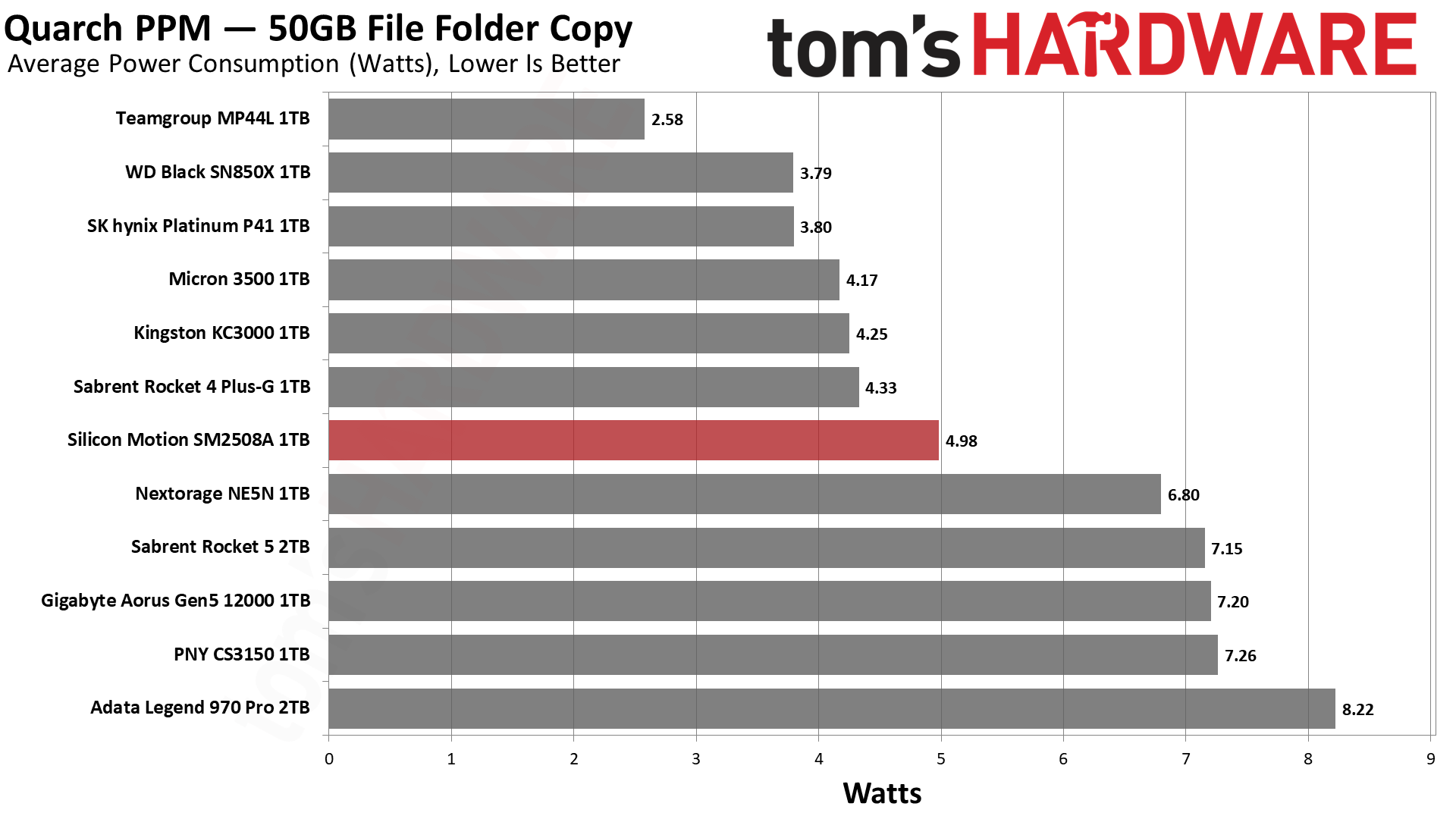


And now we get to see what kind of efficiency gains the SM2508 can manage. Max power consumption is around 9W, which is better than the up to 12W we see with the E26-based Rocket 5 and the almost 14W of the IG5666-based Legend 970 Pro. This is a significant power savings, especially considering that it could potentially use more efficient flash in the future.
Given the average power consumption and performance level of the drive, it ends up being about as efficient as the Micron 3500 — or the Crucial T500, if you prefer — which is an excellent result. The T500 is our top pick for a laptop SSD given, in part, its good power efficiency. Our SM2508 sample ends up being twice as efficient as the Legend 970 Pro.
Does this mean you can run the drive without a heatsink? Yes. The drive reached a maximum temperature of 75°C in our testing, which is 8°C below the reported first throttling limit. We prefer more headroom than this — usually at least 10°C — but conditions will vary from system to system. A heatsink is recommended, especially as the larger capacity versions of the drive have the potential to put out more heat. We don’t recommend using this drive in a laptop, but it might be feasible in some cases.
Digging deeper, it’s clear SMI did some work to get the power utilization just right. According to S.M.A.R.T., the top power state grabs a maximum of 10W — compared to 11.50W or so for the E26 — but the overall power configuration uses less power across the curve. This means much lower idle power use compared to the E26 and especially the IG5666. SMI also touted its built-in power management which, we can say, will further reduce idle power consumption in a properly configured machine.
Test Bench and Testing Notes
| CPU | Intel Core i9-12900K |
| Motherboard | Asus ROG Maximus Z790 Hero |
| Memory | 2x16GB G.Skill DDR5-5600 CL28 |
| Graphics | Intel Iris Xe UHD Graphics 770 |
| CPU Cooling | Enermax Aquafusion 240 |
| Case | Cooler Master TD500 Mesh V2 |
| Power Supply | Cooler Master V850 i Gold |
| OS Storage | Sabrent Rocket 4 Plus 2TB |
| Operating System | Windows 11 Pro |
We use an Alder Lake platform with most background applications such as indexing, Windows updates, and anti-virus disabled in the OS to reduce run-to-run variability. Each SSD is prefilled to 50% capacity and tested as a secondary device. Unless noted, we use active cooling for all SSDs.
SMI SM2508 Bottom Line
We expected good things from Silicon Motion’s SM2508 SSD controller, and we were not disappointed. It’s the first high-end solution not named Phison E26 to bring valuable improvements to consumer storage. The primary change is in power consumption, as the 6nm SM2508 delivers excellent power efficiency to a realm where it was previously impossible to find. The InnoGrit IG5666, built using 12nm like the E26, is a testament to that fact, as it pulled the most power of any drive in our testing via the Adata Legend 970 Pro. Easier-to-cool SSDs designed around the SM2508 will certainly be a welcome sight in this landscape.
Best of all, this improvement does not come at the cost of performance. On the contrary, the SM2508 performs very well in all of our tests and has exceptional sustained performance for a 1TB drive. We would expect similar performance, for the most part, at higher capacities using larger 1Tb dies, but the controller does have some headroom to use more dies for something a bit more impressive. We’ll see where that goes when third parties actually get drives out the door. However, the drive does quite well for itself when just using BiCS6 TLC flash and at just 1TB, so we are optimistic.
With the power consumption advantage also comes less thermal output. When testing E26-based drives, we were regularly reminded about the requirement for a heatsink. This isn’t the case with the SM2508, although we would still recommend using a heatsink with any of the current PCIe 5.0 SSDs and any SM2508-based ones in the future. Our results suggest good things to come when we finally start to see 6/7nm four-channel controllers like the Phison E31T arrive on the scene. Those would be more practical, but the SM2508 is good enough to forge its own legacy.
As it stands, it looks like it will be easy to recommend any SM2508-based drive over the current competition. There are essentially no compromises that need to be made. Well, except perhaps on price, which is a waiting game until there are actual drives available. Current expectations are that we will see products based on the SM250u within the next six months — the E26 went from prototype to product for our testing in just shy of five months. But SMI does need to hurry, as the competition certainly isn't sitting idle.
We can assume there will be a premium just for the controller. As for the flash, this is a unique situation as usually 1TB drives of this caliber are not really worth a look. With the SM2508, thanks to the flash being used, this is less of an issue. Regardless of capacity, then, it should offer the best performance once available. It’s an important step in the right direction for high-performance SSDs and we’re pleased to celebrate a new SMI controller again.
MORE: Best SSDs
MORE: How We Test HDDs And SSDs
MORE: All SSD Content

Shane Downing is a Freelance Reviewer for Tom’s Hardware US, covering consumer storage hardware.
-
Athan You haveReply
PCIe 4.0 x4 / NVMe 1.4throughout the table. Presumably those should be "PCIe 5.0". -
JarredWaltonGPU Reply
Yup, fixed. (I only edited the text; the table was a separate file that I didn't see until this was put in the CMS and live.)Athan said:You have
PCIe 4.0 x4 / NVMe 1.4throughout the table. Presumably those should be "PCIe 5.0". -
thestryker While I'm still not interested in PCIe 5.0 drives for myself this sure seems to remove that large heat issue without sacrificing performance. There's some better consistency as well which is always a welcome sight for anything using NAND. Hopefully we'll see some good implementations of this controller on the market sooner than later.Reply -
Jame5 Reply
That was literally the whole premise of the article. It can perform with the best of the PCIe5.0 SSDs without requiring a heatsink.jackt said:does it require a car radiator ? -
Jame5 What this makes me wonder is when we will finally get an 8TB QLC drive just running in 2TB SLC mode permanently. No caching. Just pure speed all the time.Reply
I would love to dream about an actual SLC drive, but I know that won't happen. TLC or QLC running in full-time SLC mode will probably be the best we will ever get. -
Notton There is finally an incentive for AMD to add PCIe 5.0 to their mobile chips.Reply
Even LNL features a paltry 4 lanes of PCIe5.0 -
pclaughton Perhaps someone more knowledgeable than me can explain why drives use DDR4 and not LPDDR4 or 5?Reply -
Amdlova AT 7w tdp need a little heat sink to keep temps in check at 9w will need something a little more.Reply
Remember that slot will receive heat from other soucers :)
